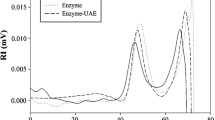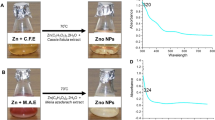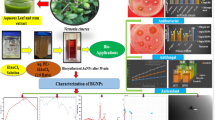Abstract
In this study, polysaccharide of Terminalia catappa L. was extracted and characterized using UV–Vis spectroscopy and FTIR spectroscopy. The polysaccharide was tested for its antibacterial activity, swarming motility, antibiofilm activity, anticancer activity and antioxidant activity. Further, the polysaccharide was subjected for carboxymethylation and chelated using Tri Sodium Tri Meta phosphate to form nanocarriers. The nanocarriers were loaded with curcumin and were characterized using FTIR, SEM, EDAX, TEM and AFM. The curcumin nanocarriers were evaluated for its drug encapsulation efficiency, drug release, invitro anticancer activity and also subjected for cellular uptake studies. The polysaccharide was found to be producing a stable and non hemotoxic nanocarrier, which could encapsulate drug and release drug efficiently.











Similar content being viewed by others
References
S. Bhaskar, F. Tian, T. Stoeger, W. Kreyling, J. M. de la Fuente, V. Grazú, P. Borm, G. Estrada, V. Ntziachristos, and D. Razansky (2010). Multifunctional Nanocarriers for diagnostics, drug delivery and targeted treatment across blood–brain barrier: perspectives on tracking and neuroimaging. PartFibreToxicol. 7, 3.
O. Flores, S. Santra, C. Kaittanis, R. Bassiouni, A. S. Khaled, A. R. Khaled, J. Grimm, and J. M. Perez (2017). PSMA-targeted theranostic nanocarrier for prostate cancer. Theranostics. 7, (9), 2477–2494.
K. Maier-Hauff, R. Rothe, R. Scholz, U. Gneveckow, P. Wust, B. Thiesen, A. Feussner, A. V. Deimling, N. Waldoefner, R. Felix, and A. Jordan (2007). Intracranial thermotherapy using magnetic nanoparticles combined with external beam radiotherapy: results of afeasibility study on patients with glioblastoma multiforme. J. Neurooncol. 81, (1), 53–60.
G. Benelli, C.M. Lukehart (2017). Special Issue: Applications of green-synthesized nanoparticles in pharmacology, parasitology and entomology. J Clust Sci. 28, 1–2. https://doi.org/10.1007/s10876-017-1165-5
G. Benelli, R. Pavela, F. Maggi, R. Petrelli, and M. Nicoletti (2017). Commentary: making green pesticides greener? The potential of plant products for nanosynthesis and pest control. J Clust Sci. 28, 3–10.
G. Benelli (2016). Green synthesized nanoparticles in the fight against mosquito-borne diseases and cancer—a brief review. Enzyme Microb Technol. 95, 58–68.
S. Parveen, R. Misra, and S. K. Sahoo (2012). Nanoparticles: a boon to drug delivery, therapeutics, diagnostics and imaging. Nanomedicine 8, (2) 147,
J. Clark, E. M. Singer, D. R. Korns, S. S. Smith (2004). Design and analysis of nanoscale bioassemblies. Biotechniques. 36, (6), 992–6, 998–1001.
J. A. Champion, Y. K. Katare, and S. Mitragotri (2007). Making polymeric micro- and nanoparticles of complex shapes. Proceedings of the National Academy of Sciences of the United States of America. 104, (29), 11901–11904.
C. MisDing and Z. Li (2017). A review of drug release mechanisms from nanocarrier systems. Materials Science & Engineering. C Mater Biol Appl. 76, 1440–1453.
J. Huang, Y. Xue, N. Cai, H. Zhang, K. Wen, X. Luo, S. Long, and F. Yu (2015). Efficient reduction and pH co-triggered DOX-loaded magnetic nanogel carrier using disulphide crosslinking. Mater Sci Eng C Mater Biol Appl. 46, 41–51.
V. P. Torchilin (2004). Targeted polymeric micelles for delivery of poorly soluble drugs. Cell Mol Life Sci. 61, (19–20), 2549–2559.
A. R. Nicholas, M. J. Scott, N. I. Kennedy, and M. N. Jones (2000). Effect of grafted polyethylene glycol (PEG) on the size, encapsulation efficiency and permeability of vesicles. BiochimBiophys Acta. 1463, (1), 167–178.
K. Thanzami, C. Malsawmtluangi, H. Lalhlenmawia, T. V. Seelan, S. Palanisamy, R. Kandasamy, and L. Pachuau (2015). Characterization and in vitro antioxidant activity of AlbiziastipulataBoiv. gum exudates. Int J Biol Macromol. 80, 231–239.
P. D. Choudhary, H. A. Pawar (2014). Recently Investigated Natural Gums and Mucilages as Pharmaceutical Excipients: An Overview. J Pharm. (ii), 1–9.
D. Verbeken, S. Dierckx, and K. Dewettinck (2003). Exudate gums: occurrence, production, and applications. Appl Microbiol Biotechnol. 63, (1), 10–21.
F. Khorram, A. Ramezanian, and S. M. H. Hosseini (2017). Shellac, gelatin and Persian gum as alternative coating for orange fruit. Sci Hort. 225, 22–28.
I. Khan, K. Saeed, I. Khan (2017). Nanoparticles: properties, applications and toxicities. Arab J Chem. In Press. https://doi.org/10.1016/j.rabjc.2017.05.011
M. Hadian, S. M. H. Hosseini, A. Farahnaky, and G. Z. Mesbahi (2017). Optimization of functional nanoparticles formation in associative mixture of water-soluble portion of Farsi gum and beta-lactoglobulin. Int J BiolMacromol. 102, 1297–1303.
R. Sharma and V. Rana (2017). Effect of carboxymethylation on rheological and drug release characteristics of Terminalia catappa gum. CarbohydrPolym. 175, 728–738.
Abhishek Rimpy and M. Ahuja (2017). Evaluation of carboxymethyl moringa gum as nanometric carrier. CarbohydrPolym. 174, 896–903.
S. Ghayempour, M. Montazer, and M. Mahmoudi Rad (2016). Encapsulation of Aloe vera extract into natural Tragacanth Gum as a novel green wound healing product. Int J Biol Macromol. 93, 344–349.
F. F. Simas-Tosin, R. R. Barraza, D. Maria-Ferreira, M. F. Werner, C. H. Baggio, R. Wagner, F. R. Smiderle, E. R. Carbonero, G. L. Sassaki, M. Iacomini, and P. A. Gorin (2014). Glucuronoarabinoxylan from coconut palm gum exudate: chemical structure and gastroprotective effect. Carbohydr Polym. 107, 65–71.
V. K. Sharma and B. Mazumdar (2013). Feasibility and characterization of gummy exudate of Cochlospermum religiosum as pharmaceutical excipient. Ind Crops Prod. 50, 776–786.
E. K. Selvi, J. M. Kumar, and R. B. Sasidhar (2017). Anti-proliferative activity of Gum kondagogu (Cochlospermum gossypium)-gold nanoparticle constructs on B16F10 melanoma cells: An in vitro model. Bioact Carbohydr Diet Fibre. 11, 38–47.
A. Rezaei, H. Tavanai, and A. Nasirpour (2016). Fabrication of electrospun almond gum/PVA nanofibers as a thermostable delivery system for vanillin. Int J Biol Macromol. 91, 536–543.
F. Bouaziz, M. Ben Romdhane, C. BoissetHelbert, L. Buon, F. Bhiri, S. Bardaa, D. Driss, M. Koubaa, A. Fakhfakh, Z. Sahnoun, F. Kallel, N. Zghal, and S. EllouzChaabouni (2014). Healing efficiency of oligosaccharides generated from almond gum (Prunus amygdalus) on dermal wounds of adult rats. J Tissue Viability. 23, (3), 98–108.
F. Bouaziz, M. Koubaa, K. Ben Jeddou, F. Kallel, C. BoissetHelbert, A. Khelfa, R. EllouzGhorbel, S. EllouzChaabouni. Water-soluble polysaccharides and hemicelluloses from almond gum: Functional and prebiotic properties. Int J Biolmacromol. 93, 359–368.
F. Bouaziza, M. Koubaa, M. Neifar, S. Z. Ellouzi, S. Besbes, F. Chaaria, A. Kamoune, M. Chaabounie, S. E. Chaabouni, and R. E. Ghorbela (2015). Feasibility of using almond gum as coating agent to improve the quality of fried potato chips: evaluation of sensorialproperties. LWT—Food Sci Technol. 65, 800–807.
N. Mahfoudhi, M. Sessa, M. Chouaibi, G. Ferrari, F. Donsì, and S. Hamdi (2014). Assessment of emulsifying ability of almond gum in comparison with gum arabic using response surface methodology. Food Hydrocolls. 37, 49–59.
F. Bouaziz, C. B. Helbertm, M. B. Romdhane, M. Koubaa, F. Bhiri, F. Kallel, F. Chaari, D. Driss, L. Buon, and S. E. Chaabouni (2014). Structural data and biological properties of almond gum oligosaccharide: application to beef meat preservation. Int J Biolmacromol. 72, 472–479.
S. A. Hussain and V. Jaisankar (2017). An eco-friendly synthesis, characterisation and antibacterial applications of novel almond gum–poly(acrylamide) based hydrogel silver nanocomposite. Polym Test. 62, 154–161.
G. Dodi, A. Pala, E. Barbu, D. Peptanariu, D. Hritcu, M. I. Popa, and B. I. Tamba (2016). Carboxymethyl guar gum nanoparticles for drug delivery applications: Preparation and preliminary in vitro investigations. Mater Sci Eng C Mater Biol Appl. 63, 628–636.
D. G. Ha, S. L. Kuchma, and G. A. O’Toole (2014). Plate-based assay for swarming motility in Pseudomonas aeruginosa. Methods Mol Biol. 1149, 67–72.
G. Rajivgandhi, R. Vijayan, M. Maruthupandy, B. Vaseeharan, N. Manoharan (2018). Antibiofilm effect of Nocardiopsis sp. GRG 1 (KT235640) compound against biofilm forming Gram negative bacteria on UTIs. Microb Pathog. 4010 (18), 30018–4.
I. F. Benzie and J. J. Strain (1996). The ferric reducing ability of plasma (FRAP) as a measure of “antioxidant power”: the FRAP assay. Anal Biochem. 239, (1), 70–76.
M. Maizura, A. Aminah, and W. M. Wan Aida (2001). Total phenolic content and antioxidant activity of kesum (Polygonum minus), ginger (Zingiber officinale) and turmeric (Curcuma longa) extract. Int Food Res J. 18, 529–534.
M. R. Saha, S. M. R. Hasan, R. Akter, M. M. Hossain, M. S. Alam, M. A. Alam, M. E. H. Mazumder. In vitro free radical scavenging activity of methanol extract of the leaves of Mimusopselengilinn. J. Bangl. Vet. Med. 6 (2), 197–202.
A. Anitha, V. G. Deepagan, V. V. D. Rani, D. Menon, S. V. Nair, and R. Jayakumar (2011). Preparation, characterization, invitro drug release and biological studies of curcumin loaded dextran sulphate-chitosan nanoparticles. Carbohydr polym. 84, 1158–1164.
N. S. Rejinold, M. Muthunarayanan, V. V. Divyarani, P. R. Sreerekha, K. P. Chennazhi, S. V. Nair, H. Tamura, and R. Jayakumar (2011). Curcumin-loaded biocompatible thermoresponsive polymeric nanoparticles for cancer drug delivery. J Colloid Interface Sci. 360, (1), 39–51.
G. Dodi, D. Hritcu, and I. M. Popa (2011). Carboxymethylation of guar gum: synthesis and characterization. Cellulose Chem Technol. 45, (3), 171–176.
A. V. Samrot, T. Jahnavi, Akansha, S. Padmanaban, S. A. Philip, U. Burman, and A. M. Rabel (2016). Chelators influenced synthesis of chitosan- carboxymethyl cellulose micro particles for controlled drug delivery. Appl Nano Sci. 6, 1219–1231.
A. V. Samrot, Ujjala Burman, Sheryl Ann Philip, N. Shobana, and Kumar Chandrasekaran (2018). Synthesis of curcumin loaded polymeric nanoparticles from crab shell derived chitosan for drug delivery. Inform Med Unlocked. 10, 159–182.
J. Gopal, S. Chun, V. Anthonydasan, S. Jung, B. N. Mwang’ombe, M. Muthu, and I. Sivanesan (2018). Assays evaluating antimicrobial activity of nanoparticles: a myth buster. J Clust Sci. 29, (2), 207–213.
A. Soriano, F. Marco, J. A. Martínez, E. Pisos, M. Almela, V. P. Dimova, D. Alamo, M. Ortega, J. Lopez, and J. Mensa (2008). Influence of vancomycin minimum inhibitory concentration on the treatment of methicillin-resistant Staphylococcus aureus bacteremia. Clin Infect Dis. 46, (2), 193–200.
P. Udompornmongkol and B. H. Chiang (2015). Curcumin-loaded polymeric nanoparticles for enhanced anti-colorectal cancer applications. J Biomater Appl. 0, (0), 1–10.
T. Mahendran, P. A. Williams, G. O. Phillips, S. Al-Assaf, and T. C. Baldwin (2008). New insightsinto the structural characteristics of the arabinogalactan-protein (AGP) fraction of gum arabic. J Agric Food Chem. 56, (19), 9269–9276.
A. Rezaei, A. Nasirpour, and H. Tavanai (2016). Fractionation and some physicochemical properties of almond gum (Amygdaluscomunis L.) exudates. Food Hydrocoll. 60, 461–469.
F. Bouaziz, M. Koubaa, C. B. Helbert, F. Kallel, D. Driss, I. Kacem, R. Ghorbel, and S. E. Chaabouni (2015). Purification, structural data and biological properties of polysaccharide from Prunus amygdalus gum. Int J Food Sci Technol. 50, 578–584.
V. E. Ooi and F. Liu (2000). Immunomodulation and anti-cancer activity of polysaccharide-protein complexes. Curr Med Chem. 7, (7), 715–729.
E. Z. Gomaa (2013). In vitro antioxidant, antimicrobial, and antitumor activities of bitter almond and sweet apricot (Prunus armeniaca L.) kernels. Food Sci Biotechnol. 22, (2), 455–463.
S. M. Bagheri, A. Abdian-Asi, M. T. Moghadam, M. Yadegari, A. Mirjalili, F. Zare-Mohazabieh, and H. Momeni (2017). Antitumor effect of Ferulaassafoetida oleo gum resin against breast cancer induced by 4T1 cells in BALB/c mice. J Ayurveda Integr Med. 8, (3), 152–158.
G. Mhinzi, L. Mghweno, and J. Buchweishaija (2008). Intra-species variation of the properties of gum exudates from two Acacia species of the series Gummiferae. Food Chem. 107, 1407–1412.
H. Pawar, M. Karde, N. Mundle, P. Jadhav, and K. Mehra (2014). Phytochemical evaluation and curcumin content determination of turmeric rhizomes collected from Bhandara district of Maharashtra (India). Med chem. 4, 588–591.
D. Griffith, W. Bernt, P. Hole, J. Smith, A. Malloy, B. Carr (2011). Zetapotential measurement of nanoparticles by nanoparticle tracking analysis. NSTI-Nanotech. 1.
Author information
Authors and Affiliations
Corresponding author
Ethics declarations
Conflict of interest
The authors have no conflict of interest.
Rights and permissions
About this article
Cite this article
Samrot, A.V., Suvedhaa, B., Sahithya, C.S. et al. Purification and Utilization of Gum from Terminalia Catappa L. for Synthesis of Curcumin Loaded Nanoparticle and Its In Vitro Bioactivity Studies. J Clust Sci 29, 989–1002 (2018). https://doi.org/10.1007/s10876-018-1412-4
Received:
Published:
Issue Date:
DOI: https://doi.org/10.1007/s10876-018-1412-4




